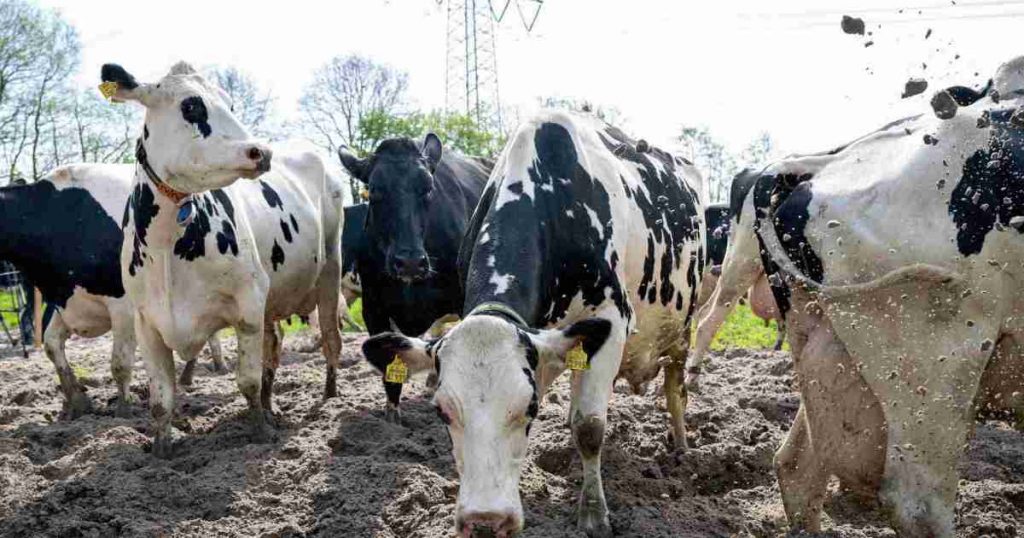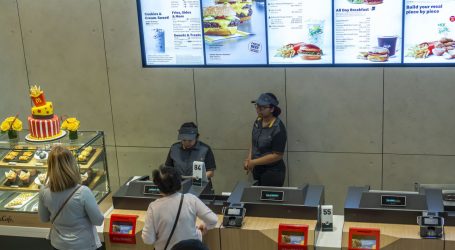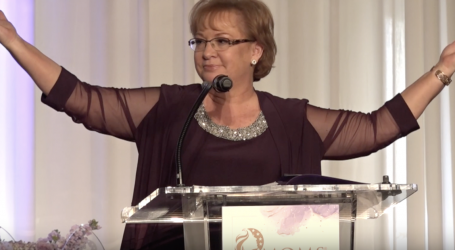Environmentalists Are Having a Cow Over Tyson Foods’ “Climate Friendly” Beef
Sina Schuldt/dpa/Zuma
This story was originally published by Inside Climate News and is reproduced here as part of the Climate Desk collaboration.
About five miles south of Broken Bow, in the heart of central Nebraska, thousands of cattle stand in feedlots at Adams Land & Cattle Co., a supplier of beef to the meat giant Tyson Foods.
From the air, the feedlots look dusty brown and packed with cows—not a vision of happy animals grazing on open pastureland, enriching the soil with carbon. But when the animals are slaughtered, processed, and sent onward to consumers, labels on the final product can claim that they were raised in a “climate friendly” way.
In late 2022, Tyson—one of the country’s “big four” meat packers—applied to the US Department of Agriculture, seeking a “climate friendly” label for its Brazen Beef brand. The production of Brazen Beef, the label claims, achieves a “10 percent greenhouse gas reduction.” Soon after, the USDA approved the label.
Immediately, environmental groups questioned the claim and petitioned the agency to stop using it, citing livestock’s significant greenhouse gas emissions and the growing pile of research that documents them. These groups and journalism outlets, including Inside Climate News, have asked the agency for the data it used to support its rubber-stamping of Tyson’s label but have essentially gotten nowhere.
“There are lots of misleading claims on food, but it’s hard to imagine a claim that’s more misleading than ‘climate friendly’ beef,” said Scott Faber, a senior vice president at the Environmental Working Group (EWG). “It’s like putting a cancer-free label on a cigarette. There’s no worse food choice for the climate than beef.”
The USDA has since confirmed it is currently considering and has approved similar labels for more livestock companies, but would not say which ones.
On Wednesday, the EWG, a longtime watchdog of the USDA, published a new analysis, outlining its efforts over the last year to push the agency for more transparency, including asking it to provide the specific rationale for allowing Brazen Beef to carry the “climate friendly” label. Last year, the group filed a Freedom of Information Act request, seeking the data that Tyson supplied to the agency in support of its application, but received only a heavily redacted response. EWG also petitioned the agency to not allow climate friendly or low-carbon claims on beef.
To earn the “climate friendly” label, Tyson requires ranchers to meet the criteria of its internal “Climate-Smart Beef” program, but EWG notes that the company fails to provide information about the practices that farmers are required to adopt or about which farmers participate in the program. The only farm it has publicly identified is the Adams company in Nebraska.
A USDA spokesperson told Inside Climate News it can only rely on a third-party verification company to substantiate a label claim and could not provide the data Tyson submitted for its review.
“Because Congress did not provide USDA with on-farm oversight authority that would enable it to verify these types of labeling claims, companies must use third-party certifying organizations to substantiate these claims,” the spokesperson wrote in an email, directing Inside Climate News to the third-party verifier or Tyson for more information.
The third-party verification company, Where Food Comes From, did not respond to emailed questions from Inside Climate News, and Tyson did not respond to emails seeking comment.
The USDA said it is reviewing EWG’s petitions and announced in June 2023 that it’s working on strengthening the “substantiation of animal-raising claims, which includes the type of claim affixed to the Brazen Beef product.”
The agency said other livestock companies were seeking similar labels and that the agency has approved them, but would not identify those companies, saying Inside Climate News would have to seek the information through a Freedom of Information Act request.
“They’re being incredibly obstinate about sharing anything right now,” said Matthew Hayek, a researcher with New York University who studies the environmental and climate impacts of the food system. “Speaking as a scientist, it’s not transparent and it’s a scandal in its own right that the government can’t provide this information.”
This lack of transparency from the agency worries environmental and legal advocacy groups, especially now that billions of dollars in taxpayer funds are available for agricultural practices deemed to have benefits for the climate. The Biden administration’s signature climate legislation, the Inflation Reduction Act, appropriated nearly $20 billion for these practices; another $3.1 billion is available through a Biden-era program called the Partnership for Climate-Smart Commodities.
“This is an important test case for USDA,” Faber said. “If they can’t say no to a clearly misleading climate claim like ‘climate friendly’ beef, why should they be trusted to say no to other misleading climate claims? There’s a lot of money at stake.”
Tyson is the primary recipient of about $60 million in funding from the Climate-Smart Commodities program that will help the company “expand climate-smart markets and increase carbon sequestration and reduce emissions in the production of beef and row crops for livestock feed,” according to the USDA.
Other recipients of that grant include McDonald’s, the biggest buyer of beef in the United States, and Where Food Comes From.
The funds for the Climate-Smart Commodities program come from the agency’s Commodity Credit Corporation and are not subject to Congressional approval or oversight.
Last year, the Center for Biological Diversity submitted a Freedom of Information Act request to the USDA, asking for details about funding to support “low carbon” beef. The agency’s response was heavily redacted and the Center is now appealing.
“The industry continues to make big claims about sequestering carbon, with no science or scale to back it up, and uses very fuzzy accounting for their methane emissions, even though cattle are the main agricultural source of domestic methane emissions,” explained Jennifer Molidor, a senior campaigner for the group, in an email to Inside Climate News. “Brazen Beef has used a third party auditor, but it’s not clear what baseline and metrics they are using either.”
“If the USDA wants climate-smart agriculture, propping up the beef industry isn’t the smartest way to go about it,” Molidor added.
On its website, Tyson claims to reach its 10 percent greenhouse gas reduction through improved grazing methods and practices that reduce emissions from growing feed. But it does not publish the data and it says farmers can “customize their practices depending on their unique geographic location and circumstances.”
The company also says it worked with two environmental advocacy groups, the Environmental Defense Fund and The Nature Conservancy, to develop its carbon accounting methodology.
Katie Anderson, a senior director with the Environmental Defense Fund, said the organization’s role in Tyson’s Climate Smart Beef program was limited to sharing its method for measuring nitrogen, the major component of fertilizer used to grow livestock feed. When nitrogen-based fertilizer is applied to farm fields, much of it is lost to the air as nitrous oxide, a greenhouse gas 300 times more powerful than carbon dioxide.
The organization’s method calculates nitrous oxide emissions across watersheds or “entire sourcing regions,” making it less cumbersome for individual farms to calculate. “The models make it easier and more accurate for food and agriculture companies to report progress toward the nitrogen-related parts of their climate and water quality goals for their direct operations and supply chains,” Anderson said.
Tyson did not pay the group for its contribution.
The Nature Conservancy, which has received funding from Tyson for some of its conservation projects in the company’s home state of Arkansas, was paid to share some of its expertise on sustainable agriculture and translating data from farmers.
“We only shared knowledge and advice, which Tyson took into consideration when working on the model,” said Nancy Labbe, the co-director of TNC’s Regenerative Grazing Lands program, who noted that the data on Tyson’s accounting methodology would have to come from the company itself.
Both the Environmental Defense Fund and The Nature Conservancy have received funding from the USDA via the Climate-Smart Commodities program. Silvia Secchi, a natural resource economist at the University of Iowa and outspoken critic of U.S. agricultural policy, said the environmental groups, universities, and corporations taking money from the USDA for climate-focused efforts should all be subject to the same rules.
“USDA should have a transparent methodology that’s applicable to everyone—the outsourcing, the monitoring, the verification—for all these groups that have incentives to make things look better than they are,” Secchi said. “There’s no transparency. How are they actually going to verify that farmers are reducing nitrogen? Are they getting GPS coordinates for tractors every day of the year? I think it’s complete bullshit. They’re only looking at select indicators, not the whole system.”i
Already, the agency has expanded its definition of “climate smart” to practices critics say are not climate smart and may actually lead to more greenhouse gas emissions.
Though it has long worked to downplay its climate impact, the livestock industry has become increasingly sensitive to growing consumer awareness of livestock’s huge carbon footprint. It has spent millions lobbying against climate action and courting academic specialists to minimize the greenhouse gas emissions of livestock.
Last month the American Farm Bureau Federation, the country’s most powerful farm lobbying group, which had long denied the science behind human-caused climate change, celebrated a drop in agricultural greenhouse gas emissions reported by the Environmental Protection Agency.
“America’s farmers and ranchers are leading the way in greenhouse gas emission reduction through voluntary conservation efforts and market-based incentives,” the Farm Bureau said, noting that agricultural emissions fell by 2 percent from 2021 to 2022, “ the largest decrease of any economic sector.”
But Ben Lilliston, the director of rural strategies and climate change for the Institute for Agriculture and Trade Policy, noted that the drop was not the result of voluntary farm practices. High fertilizer prices, in part caused by the war in Ukraine, resulted in less fertilizer use as farmers switched to planting soybeans rather than corn, which is especially nitrogen intensive. Less corn and less fertilizer led to lower nitrous oxide emissions. Over roughly the same period, a multi-year drought killed thousands of cattle, resulting in lower methane emissions from cattle. (Cattle are the biggest source of agricultural methane, largely from their belches and from the way their manure is stored.)
“Those are the two drivers that reduced emissions,” Lilliston said. “It wasn’t anything the industry did or anything farmers did.”
“When we do reduce the number of cattle, we reduce emissions, and when we do plant other crops besides corn—crops that aren’t as fertilizer intensive—emissions go down,” Lilliston added. “This is the pathway to reducing greenhouse gas emissions.”
The downplaying of livestock’s carbon impact isn’t just the work of the American farm and livestock lobbies. The Food and Agriculture Organization of the United Nations last year came under fire as reporters revealed that researchers had been pressured to downplay livestock’s climate impact in a landmark report.
Last month, Hayek, of NYU, accused the FAO of misusing his data in a subsequent report that he and others say downplayed the importance of reducing beef and dairy consumption to reduce greenhouse gas emissions, which research has demonstrated is critical, especially in developing countries.
The food system, from farm to consumer, accounts for about one-third of all human-caused greenhouse gas emissions, with livestock production accounting for about two-thirds of that. It is now widely understood that emissions from the food system alone will push temperatures past the 1.5 degree Celsius target set in the Paris Agreement. Assuming the world continues to eat meat and dairy the way it does now, most of the warming projected to come from the food system will come from livestock, recent research has found.
Industry efforts to pursue “low carbon” and “climate friendly” labeling are another step toward minimizing its climate and broader environmental impacts—and they further mislead consumers, critics say. “It implies there’s a beef choice that’s good for the climate,” Faber said.
The debate over low carbon beef claims could, in theory, end up facing legal challenges. In February, the New York Attorney General’s office sued the world’s largest beef company, Brazil-based JBS, for misleading consumers by promising to achieve “net zero” emissions by 2040, even though the company clearly has a growth strategy that relies on ramping up beef production.
“It would be difficult to achieve if not impossible,” said Peter Lehner, an attorney for Earthjustice whose work focuses on agriculture. “The measures JBS are taking are not enough and that would overlap with Tyson.”
“You can’t claim to be climate friendly or net zero because beef production ineluctably uses an enormous amount of land and emits an enormous amount of methane and nitrous oxide,” he added. “You can reduce that, but you’re still not close to a climate friendly food.”





